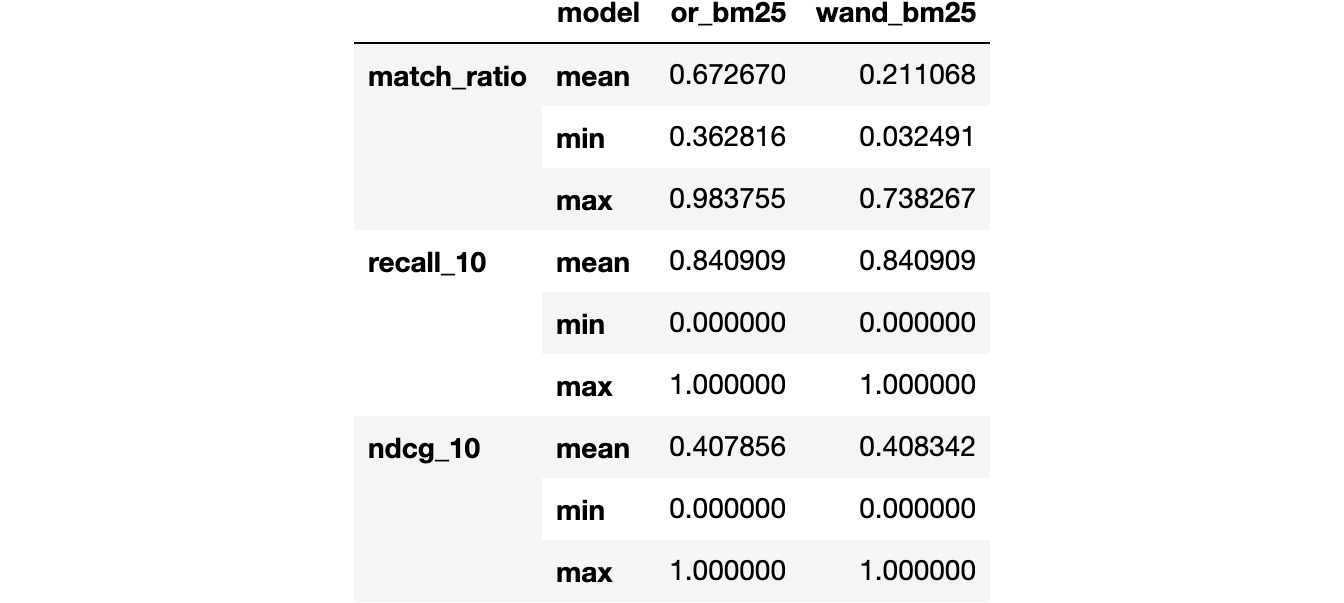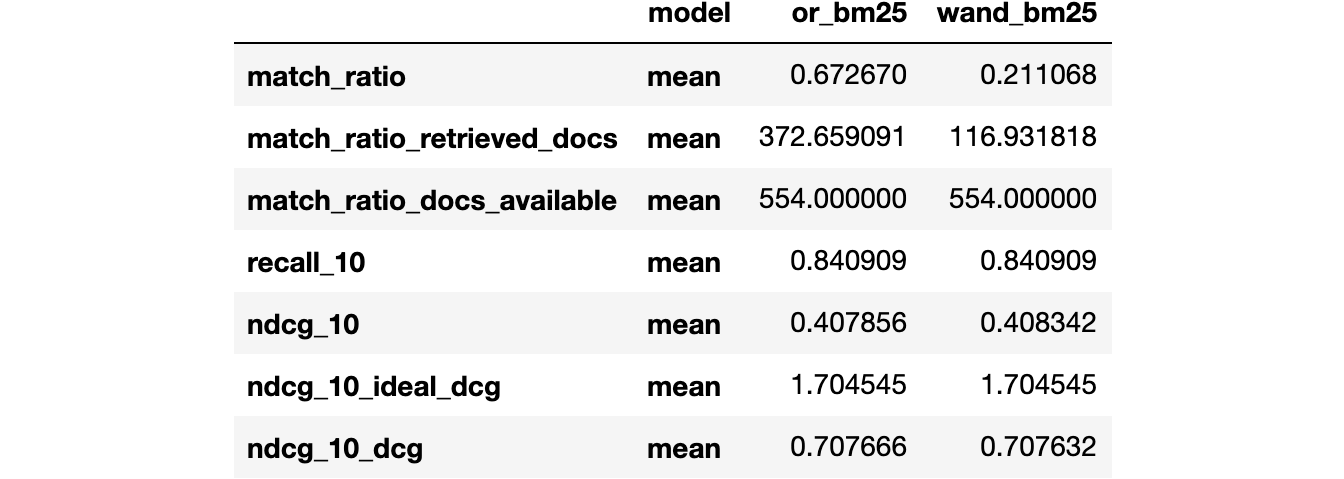Build a basic text search application from python with Vespa: Part 2
Evaluate search engine experiments using Python.
We want to enable Vespa users to run their experiments from python. This tutorial illustrates how to define query models and evaluation metrics to perform search engine experiments.
UPDATE 2023-12-05: learntorank is deprecated.

Photo by Eugene Golovesov on Unsplash
We show how to use the pyvespa API to run search engine experiments based on the text search app we built in the first part of this tutorial series. Specifically, we compare two different matching operators and show how to reduce the number of documents matched by the queries while keeping similar recall and precision metrics.
We assume that you have followed the first tutorial and have a variable app holding the Vespa connection instance that we established there. This connection should be pointing to a Docker container named cord19 running the Vespa application.
Feed additional data points
We will continue to use the CORD19 sample data that fed the search app in the first tutorial. In addition, we are going to feed a few additional data points to make it possible to get relevant metrics from our experiments. We tried to minimize the amount of data required to make this tutorial easy to reproduce. You can download the additional 494 data points below:
from pandas import read_csv
parsed_feed = read_csv("https://data.vespa-cloud.com/blog/cord19/parsed_feed_additional.csv")
parsed_feed.head(5)

We can then feed the data we just downloaded to the app via the feed_data_point method:
for idx, row in parsed_feed.iterrows():
fields = {
"cord_uid": str(row["cord_uid"]),
"title": str(row["title"]),
"abstract": str(row["abstract"])
}
response = app.feed_data_point(
schema = "cord19",
data_id = str(row["cord_uid"]),
fields = fields,
)
Define query models to compare
A QueryModel is an abstraction that encapsulates all the relevant information controlling how your app matches and ranks documents. Since we are dealing with a simple text search app here, we will start by creating two query models that use BM25 to rank but differ on how they match documents.
from learntorank.query import QueryModel, OR, WeakAnd, Ranking
or_bm25 = QueryModel(
name="or_bm25",
match_phase=OR(),
ranking=Ranking(name="bm25")
)
The first model is named or_bm25 and will match all the documents that share at least one token with the query.
from learntorank.query import WeakAnd
wand_bm25 = QueryModel(
name="wand_bm25",
match_phase=WeakAnd(hits=10),
ranking=Ranking(name="bm25")
)
The second model is named wand_bm25 and uses the WeakAnd operator, considered an accelerated OR operator. The next section shows that the WeakAnd operator matches fewer documents without affecting the recall and precision metrics for the case considered here. We also analyze the optimal hits parameter to use for our specific application.
Run experiments
We can define which metrics we want to compute when running our experiments.
from learntorank.evaluation import MatchRatio, Recall, NormalizedDiscountedCumulativeGain
eval_metrics = [
MatchRatio(),
Recall(at=10),
NormalizedDiscountedCumulativeGain(at=10)
]
MatchRatio computes the fraction of the document corpus matched by the queries. This metric will be critical when comparing match phase operators such as the OR and the WeakAnd. In addition, we compute Recall and NDCG metrics.
We can download labeled data to perform our experiments and compare query models. In our sample data, we have 50 queries, and each has a relevant document associated with them.
import json, requests
labeled_data = json.loads(
requests.get("https://data.vespa-cloud.com/blog/cord19/labeled_data.json").text
)
labeled_data[:3]
[{'query_id': 1,
'relevant_docs': [{'id': 'kqqantwg', 'score': 2}],
'query': 'coronavirus origin'},
{'query_id': 2,
'relevant_docs': [{'id': '526elsrf', 'score': 2}],
'query': 'coronavirus response to weather changes'},
{'query_id': 3,
'relevant_docs': [{'id': '5jl6ltfj', 'score': 1}],
'query': 'coronavirus immunity'}]
Evaluate
Once we have labeled data, the evaluation metrics to compute, and the query models we want to compare, we can run experiments with the evaluate method. The cord_uid field of the Vespa application should match the id of the relevant documents.
from learntorank.evaluation import evaluate
evaluation = evaluate(
app=app,
labeled_data=labeled_data,
query_model=[or_bm25, wand_bm25],
eval_metrics=eval_metrics,
id_field="cord_uid",
)
evaluation

The result shows that, on average, we match 67% of our document corpus when using the OR operator and 21% when using the WeakAnd operator. The reduction in matched documents did not affect the recall and the NDCG metrics, which stayed at around 0.84 and 0.40, respectively. The Match Ratio will get even better when we experiment with the hits parameter of the WeakAnd further down in this tutorial.
There are different options available to configure the output of the evaluate method.
Specify summary statistics
The evaluate method returns the mean, the median, and the standard deviation of the metrics by default. We can customize this by specifying the desired aggregators. Below we choose the mean, the max, and the min as an example.
evaluation = evaluate(
app=app,
labeled_data=labeled_data,
query_model=[or_bm25, wand_bm25],
eval_metrics=eval_metrics,
id_field="cord_uid",
aggregators=["mean", "min", "max"]
)
evaluation

Check detailed metrics output
Some of the metrics have intermediate results that might be of interest. For example, the MatchRatio metric requires us to compute the number of matched documents (retrieved_docs) and the number of documents available to be retrieved (docs_available). We can output those intermediate steps by setting detailed_metrics=True.
evaluation = evaluate(
app=app,
labeled_data=labeled_data,
query_model=[or_bm25, wand_bm25],
eval_metrics=eval_metrics,
id_field="cord_uid",
aggregators=["mean"],
detailed_metrics=True
)
evaluation

Get per-query results
When debugging the results, it is often helpful to look at the metrics on a per-query basis, which is available by setting per_query=True.
evaluation = evaluate(
app=app,
labeled_data=labeled_data,
query_model=[or_bm25, wand_bm25],
eval_metrics=eval_metrics,
id_field="cord_uid",
per_query=True
)
evaluation.head(5)

Find optimal WeakAnd parameter
We can use the same evaluation framework to find the optimal hits parameter of the WeakAnd operator for this specific application. To do that, we can define a list of query models that only differ by the hits parameter.
wand_models = [QueryModel(
name="wand_{}_bm25".format(hits),
match_phase=WeakAnd(hits=hits),
ranking=Ranking(name="bm25")
) for hits in range(1, 11)]
We can then call evaluate as before and show the match ratio and recall for each of the options defined above.
evaluation = evaluate(
app=app,
labeled_data=labeled_data,
query_model=wand_models,
eval_metrics=eval_metrics,
id_field="cord_uid",
aggregators=["mean"],
)
evaluation.loc[["match_ratio", "recall_10"], ["wand_{}_bm25".format(hits) for hits in range(1, 11)]]

As expected, we can see that a higher hits parameter implies a higher match ratio. But the recall metric remains the same as long as we pick hits > 3. So, using WeakAnd with hits = 4 is enough for this specific application and dataset, leading to a further reduction in the number of documents matched on average by our queries.
Clean up:
vespa_docker.container.stop()
vespa_docker.container.remove()
Conclusion
We want to enable Vespa users to run their experiments from python. This tutorial illustrates how to define query models and evaluation metrics to run search engine experiments via the evaluate method. We used a simple example that compares two different match operators and another that optimizes the parameter of one of those operators. Our key finding is that we can reduce the size of the retrieved set of hits without losing recall and precision by using the WeakAnd instead of the OR match operator.
The following Vespa resources are related to the topics explored by the experiments presented here: